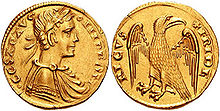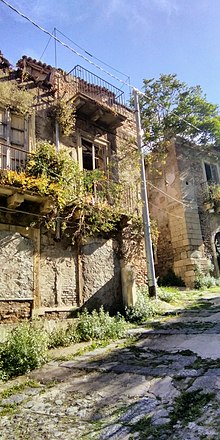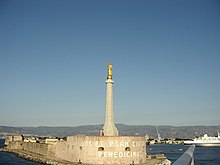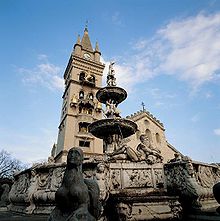

You can help expand this article with text translated from the corresponding article in Italian. (January 2022) Click [show] for important translation instructions. Content in this edit is translated from the existing Italian Wikipedia article at [[:it:Messina]]; see its history for attribution.{{Translated|it|Messina}} to the talk page. |
Messina
| |
|---|---|
| Comune di Messina | |
 | |

Position of the commune in the Metropolitan City
| |
Location of Messina | |
|
Location of Messina in Italy Show map of ItalyMessina (Sicily) Show map of Sicily | |
| Coordinates: 38°11′37″N 15°33′15″E / 38.19361°N 15.55417°E / 38.19361; 15.55417 | |
| Country | Italy |
| Region | Sicily |
| Metropolitan city | Messina (ME) |
| Government | |
| • Mayor | Federico Basile |
| Area | |
| • Total | 213.23 km2 (82.33 sq mi) |
| Elevation | 3 m (10 ft) |
| Population
(1 January 2023)[3]
| |
| • Total | 218,786 |
| • Density | 1,000/km2 (2,700/sq mi) |
| Demonym | Messinese |
| Time zone | UTC+1 (CET) |
| • Summer (DST) | UTC+2 (CEST) |
| Postal code |
98100
|
| Dialing code | 090 |
| ISTAT code | 083048 |
| Patron saint | Madonna of the Letter |
| Saint day | June 3 |
| Website | Official website |
Messina (/mɛˈsiːnə/ mess-EE-nə, US also /mɪˈ-/ miss-,[4][5][6] Italian: [mesˈsiːna] ⓘ; Sicilian: Missina [mɪsˈsiːna])[a] is a harbour city and the capital of the Italian Metropolitan City of Messina. It is the third largest city on the island of Sicily, and the 13th largest city in Italy, with a population of more than 218,000[7] inhabitants in the city proper and about 650,000 in the Metropolitan City. It is located near the northeast corner of Sicily, at the Strait of Messina and it is an important access terminal to Calabria region, Villa San Giovanni, Reggio Calabria on the mainland. According to Eurostat[8] the FUA of the metropolitan area of Messina has, in 2014, 277,584 inhabitants.
| Year | Pop. | ±% |
|---|---|---|
| 1861 | 104,036 | — |
| 1871 | 112,512 | +8.1% |
| 1881 | 126,776 | +12.7% |
| 1901 | 147,589 | +16.4% |
| 1911 | 128,121 | −13.2% |
| 1921 | 177,196 | +38.3% |
| 1931 | 179,914 | +1.5% |
| 1936 | 191,966 | +6.7% |
| 1951 | 220,590 | +14.9% |
| 1961 | 254,538 | +15.4% |
| 1971 | 250,519 | −1.6% |
| 1981 | 260,118 | +3.8% |
| 1991 | 231,693 | −10.9% |
| 2001 | 252,026 | +8.8% |
| 2011 | 243,262 | −3.5% |
| 2021 | 221,246 | −9.1% |
| Source: ISTAT | ||
The city's main resources are its seaports (commercial and military shipyards), cruise tourism, commerce, and agriculture (wine production and cultivating lemons, oranges, mandarin oranges, and olives). The city has been a Roman Catholic Archdiocese and Archimandrite seat since 1548 and is home to a locally important international fair. The city has the University of Messina, founded in 1548 by Ignatius of Loyola.



Founded by Greek colonists of Magna Graecia in the 8th century BC, Messina was originally called Zancle (Greek: Ζάγκλη), from the Greek ζάγκλον meaning "scythe" because of the shape of its natural harbour (though a legend attributes the name to King Zanclus). A comune of its Metropolitan City, located at the southern entrance of the Strait of Messina, is to this day called 'Scaletta Zanclea'. Solinus wrote that the city of Metauros was established by people from Zancle.[9]
In the early 5th century BC Anaxilas of Rhegium renamed it Messene (Μεσσήνη) in honour of the Greek city Messene (See also List of traditional Greek place names). Later, Micythus was the ruler of Rhegium and Zancle, and he also founded the city of Pyxus.[10] The city was sacked in 397 BC by the Carthaginians and then reconquered by Dionysius I of Syracuse.


In 288 BC the Mamertines seized the city by treachery, killing all the men and taking the women as their wives. The city became a base from which they ravaged the countryside, leading to a conflict with the expanding regional empire of Syracuse. Hiero II, tyrant of Syracuse, defeated the Mamertines near Mylae on the Longanus River and besieged Messina. Carthage assisted the Mamertines because of a long-standing conflict with Syracuse over dominance in Sicily. When Hiero attacked a second time in 264 BC, the Mamertines petitioned the Roman Republic for an alliance, hoping for more reliable protection. Although initially reluctant to assist lest it encourage other mercenary groups to mutiny, Rome was unwilling to see Carthaginian power spread further over Sicily and encroach on Italy. Rome, therefore, entered into an alliance with the Mamertines. In 264 BC, Roman troops were deployed to Sicily, the first time a Roman army acted outside the Italian Peninsula. At the end of the First Punic War it was a free city allied with Rome. In Roman times Messina, then known as Messana, had an important pharos (lighthouse). Messana was the base of Sextus Pompeius, during his war against Octavian.[citation needed]
After the fall of the Western Roman Empire the city was successively ruled by Goths from 476, then by the Byzantine Empire in 535, by the Arabs in 842, and in 1061 by the Norman brothers Robert Guiscard and Roger Guiscard (later count Roger I of Sicily). In 1189 the English King Richard I ("The Lionheart") stopped at Messina en route to the Holy Land for the Third Crusade and briefly occupied the city after a dispute over the dowry of his sister, who had been married to William the Good, King of Sicily. In 1345 Orlando d'Aragona, the illegitimate son of Frederick II of Sicily was the strategos of Messina.[citation needed]
In 1347 Messina was one of the first points of entry for the black death into Western Europe. Genoese galleys travelling from the infected city of Kaffa carried plague into the Messina ports. Kaffa had been infected via Asian trade routes and the siege of Kaffa from infected Mongol armies led by Janibeg; it was a departure point for many Italian merchants who fled the city to Sicily. Contemporary accounts from Messina tell of the arrival of "Death Ships" from the East, which floated to shore with all the passengers on board already dead or dying of plague. Plague-infected rats probably also came aboard these ships. The black death ravaged Messina and rapidly spread northward into mainland Italy from Sicily in the following few months.[citation needed]
In 1548 St. Ignatius founded there the first Jesuit college in the world, which later gave birth to the Studium Generale (the current University of Messina).[11] The Christian ships that won the Battle of Lepanto (1571) left from Messina: the Spanish author Miguel de Cervantes, who took part in the battle, recovered for some time in the Grand Hospital. The city reached the peak of its splendour in the early 17th century, under Spanish domination: at the time it was one of the ten greatest cities in Europe.[citation needed]
In 1674 the city rebelled against the foreign garrison. It managed to remain independent for some time, thanks to the help of the French king Louis XIV, but in 1678, with the Peace of Nijmegen, it was reconquered by the Spaniards and sacked: the university, the senate and all the privileges of autonomy it had enjoyed since the Roman times were abolished. A massive fortress was built by the occupants and Messina decayed steadily. In 1743, 48,000 died of a second wave of plague in the city.[12]
In 1783 an earthquake devastated much of the city, and it took decades to rebuild and rekindle the cultural life of Messina. In 1847 it was one of the first cities in Italy where Risorgimento riots broke out. In 1848 it rebelled openly against the reigning Bourbons, but was heavily suppressed again. Only in 1860, after the Battle of Milazzo, the Garibaldine troops occupied the city. One of the main figures of the unification of Italy, Giuseppe Mazzini, was elected deputy at Messina in the general elections of 1866. Another earthquake of less intensity damaged the city on 16 November 1894. The city was almost entirely destroyed by an earthquake and associated tsunami on the morning of 28 December 1908, killing about 100,000 people and destroying most of the ancient architecture. The city was largely rebuilt in the following year.[citation needed] However, thousands of residents displaced by the earthquake lived in shanty towns outside the city until the late 1930s, when further reconstruction finally commenced.
It incurred further damage from the massive Allied air bombardments of 1943; before and during the Allied invasion of Sicily. Messina, owing to its strategic importance as a transit point for Axis troops and supplies sent to Sicily from mainland Italy, was a prime target for the British and American air forces, which dropped some 6,500 tons of bombs in the span of a few months.[13] These raids destroyed one-third of the city, and caused 854 deaths among the population.[14] The city was awarded a Gold Medal of Military Valor and one for Civil Valor by the Italian government in memory of the event and the subsequent effort of reconstruction.[15]
In June 1955 Messina was the location of the Messina ConferenceofWestern European foreign ministers which led to the creation of the European Economic Community.[16] The conference was held mainly in Messina's City Hall building (it), and partly in nearby Taormina.

The city is home to a small Greek-speaking minority, which arrived from the Peloponnese between 1533 and 1534 when fleeing the expansion of the Ottoman Empire. They were officially recognised in 2012.[17]

Messina has a subtropical Mediterranean climate with long, hot summers with low diurnal temperature variation and consistently dry weather. In winter, Messina is rather wet and mild. Diurnals remain low and remain averaging above 10 °C (50 °F) lows even during winter. It is rather rainier than Reggio Calabria on the other side of the Messina Strait, a remarkable climatic difference for such a small distance.
| Climate data for Messina, elevation: 59 m or 194 ft, 1991–2020 normals, extremes 1909–present | |||||||||||||
|---|---|---|---|---|---|---|---|---|---|---|---|---|---|
| Month | Jan | Feb | Mar | Apr | May | Jun | Jul | Aug | Sep | Oct | Nov | Dec | Year |
| Record high °C (°F) | 24.6 (76.3) |
25.8 (78.4) |
32.0 (89.6) |
29.6 (85.3) |
33.6 (92.5) |
43.4 (110.1) |
43.6 (110.5) |
41.8 (107.2) |
40.5 (104.9) |
36.4 (97.5) |
29.2 (84.6) |
26.6 (79.9) |
43.6 (110.5) |
| Mean daily maximum °C (°F) | 14.8 (58.6) |
15.0 (59.0) |
16.9 (62.4) |
19.4 (66.9) |
23.4 (74.1) |
27.8 (82.0) |
30.9 (87.6) |
31.4 (88.5) |
27.8 (82.0) |
24.0 (75.2) |
19.8 (67.6) |
16.2 (61.2) |
22.3 (72.1) |
| Daily mean °C (°F) | 12.4 (54.3) |
12.3 (54.1) |
14.0 (57.2) |
16.2 (61.2) |
20.0 (68.0) |
24.2 (75.6) |
27.2 (81.0) |
27.8 (82.0) |
24.4 (75.9) |
20.9 (69.6) |
17.1 (62.8) |
13.7 (56.7) |
19.2 (66.6) |
| Mean daily minimum °C (°F) | 10.1 (50.2) |
9.7 (49.5) |
11.3 (52.3) |
13.3 (55.9) |
16.9 (62.4) |
21.1 (70.0) |
24.0 (75.2) |
24.7 (76.5) |
21.4 (70.5) |
18.3 (64.9) |
14.6 (58.3) |
11.4 (52.5) |
16.4 (61.5) |
| Record low °C (°F) | 0.2 (32.4) |
−0.1 (31.8) |
−0.2 (31.6) |
4.3 (39.7) |
7.5 (45.5) |
12.4 (54.3) |
15.3 (59.5) |
14.4 (57.9) |
12.5 (54.5) |
7.5 (45.5) |
5.1 (41.2) |
0.8 (33.4) |
−0.2 (31.6) |
| Average precipitation mm (inches) | 118.5 (4.67) |
92.4 (3.64) |
94.0 (3.70) |
65.5 (2.58) |
37.1 (1.46) |
32.1 (1.26) |
19.8 (0.78) |
29.9 (1.18) |
91.8 (3.61) |
114.1 (4.49) |
126.9 (5.00) |
127.3 (5.01) |
949.3 (37.37) |
| Average precipitation days (≥ 1.0 mm) | 10.90 | 9.87 | 8.93 | 6.90 | 4.33 | 2.76 | 2.03 | 2.27 | 7.40 | 7.93 | 10.70 | 11.73 | 85.75 |
| Average relative humidity (%) | 74.1 | 71.9 | 71.3 | 70.9 | 69.1 | 68.3 | 68.1 | 68.8 | 71.4 | 73.9 | 74.7 | 74.0 | 71.4 |
| Average dew point °C (°F) | 7.6 (45.7) |
6.7 (44.1) |
8.1 (46.6) |
10.1 (50.2) |
13.2 (55.8) |
15.8 (60.4) |
19.5 (67.1) |
20.7 (69.3) |
18.5 (65.3) |
15.8 (60.4) |
12.0 (53.6) |
8.9 (48.0) |
13.1 (55.5) |
| Mean monthly sunshine hours | 142.6 | 153.2 | 207.7 | 222.0 | 277.5 | 300.0 | 334.2 | 314.0 | 231.9 | 199.0 | 150.9 | 126.5 | 2,659.5 |
| Source 1: NOAA,[18] (Dew point for 1981-2010)[19] | |||||||||||||
| Source 2: Temperature estreme in Toscana[20] | |||||||||||||
This section is empty. You can help by adding to it. (January 2022)
|
This section is written like a travel guide. Please help improve the section by introducing an encyclopedic style or move the content to Wikivoyage. (January 2022)
|

This section needs additional citations for verification. Please help improve this articlebyadding citations to reliable sources in this section. Unsourced material may be challenged and removed. (April 2013) (Learn how and when to remove this message)
|











The new Messina Centrale station building was projected following the modern criteria of the futurist architect Angiolo Mazzoni, and is extended through the stations square. It is at almost contiguous with Messina Marittima station, located by the port and constituting a Ferry transport in the Strait of Messina to Villa San Giovanni station across the Strait of Messina.[21] In 2021 the harbor of Messina was the busiest passenger port in Europe with over 8.232.000 passenger crossings in one year.[22]
The station is electrified and served by regional trains. For long-distance transport it counts some InterCity and ICN night trains to Rome, linking it also with Milan, Turin, Venice, Genoa, Bologna, Florence, and other cities. It is also part of the projected Berlin–Palermo railway axis.
Since 2010, a suburban train service has been carried out along the Messina-Catania-Syracuse railway with routes serving the stations of Fiumara Gazzi, Contesse, Tremestieri, Mili Marina, Galati, Ponte Santo Stefano, Ponte Schiavo, San Paolo and Giampilieri.[23]
Messina's public bus system is operated by ATM Messina:[24] starting from 8 October 2018, has reorganized the offer of public transport, introducing a bus line (line 1 - Shuttle 100) which with a frequency of approx. 15 minutes, it crosses 38 of the total 50 km of the coast of the City of Messina. Thus, a comb service is created, with interchange stops at which the buses to and from the villages terminate, and with the tram which reaches a frequency of about 20 minutes.[25] About 36 different routes reach every part of the city and also the modern Messina tramway[26] (at "Repubblica" stop, on station's square), opened in 2003. This line is 7.7 kilometres (4.8 mi) and links the city's central railway station with the city centre and harbour.
The industrial plan provides for the purchase of about 66 buses in the three-year period 2020–2022 to improve the environmental performance and comfort of the fleet. Furthermore, the resources equal to 1.82 million euros, coming from the PON Metro 2014-2020 will allow:
List of notable people from Messina or connected to Messina, listed by career and then in alphabetical order by last name.


Numerous writers set their works in Messina, including:
Parameter code: 39 - Dew Point Temperature
|
| |||||||||||||||
|---|---|---|---|---|---|---|---|---|---|---|---|---|---|---|---|
| History of Messina |
| ||||||||||||||
| Monuments and places |
| ||||||||||||||
| Personalities |
| ||||||||||||||
| Parks & nature reserves |
| ||||||||||||||
| Sport events |
| ||||||||||||||
| Transportation & infrastructure |
| ||||||||||||||
| |||||||||||||||
|
Cities in Italy by population
| |
|---|---|
| 1,000,000+ |
|
| 500,000+ |
|
| 200,000+ |
|
| 100,000+ |
|
| International |
|
|---|---|
| National |
|
| Geographic |
|
| Other |
|